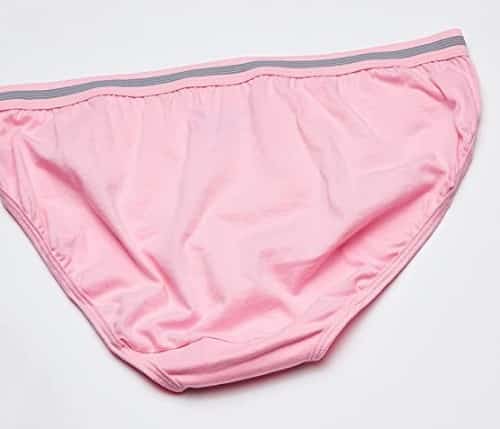Does Not Wearing Panties Cause Yeast Infection?
If you’ve got a yeast infection, it may be worth trying to go underwear-free. According to Pari Ghodsi, board-certified ob-gyn and expert in yeast infections, going underwear-free may help treat your infection. But there are some precautions you need to take when going underwear-free.
Table of Contents
Synthetic fabrics trap moisture
Synthetic underwear can increase your risk of yeast infection and urinary tract infections, especially if you wear them during periods. Most synthetic fabrics do not breathe, which traps moisture, and therefore, promote the growth of yeast. The moisture trapped inside the underwear can irritate your skin and cause an infection.
If you’re traveling on vacation, avoid wearing wet underwear. The wetness can create a breeding ground for yeast. And it’s important to pay attention to the pH of the fabric. Keeping the vagina’s pH between 3.5 and 4.5 is essential to keeping yeast infections at bay.
Synthetic materials don’t allow the area to breathe, which means they trap moisture and heat, creating a perfect breeding ground for a yeast infection. Most people only wear one pair of underwear a day, so washing them isn’t necessary. However, you shouldn’t feel restricted to only wearing one pair a day.
Yeast infections can be caused by synthetic fabrics, so it’s vital to change into dry clothes as soon as possible. It’s also a good idea to bring an extra swimsuit when you go swimming. Also, you should avoid wearing underwear made of synthetic materials. These fabrics trap heat and make you sweat more, which creates a perfect environment for the growth of yeast. Instead, wear cotton underwear that breathes and allows moisture to escape.
Cotton underwear absorbs moisture better than silk or lace
Cotton is the ideal fabric for underwear. It is easy to maintain, easily dyed, and has a long lifespan. Also, cotton is a comfortable material for sensitive skin. It can be used for a range of purposes, from underwear to camisoles and base layers.

It is also breathable and absorbs moisture better than other materials, so it is an ideal choice for workout undies. Compared to lace and silk, cotton underwear reduces the risk of bacterial vaginitis and yeast infections. Silk and lace are not as absorbent and are more likely to irritate skin. It is also important to choose undies with a cotton crotch, as these will keep you dry and comfortable during vigorous activity.
Cotton is also cheaper and more readily available than other fabrics. And unlike silk or lace, cotton underwear is hypoallergenic, meaning they won’t irritate your skin. Also, cotton prevents moisture and heat build-up. It also keeps odor away.
Cotton underwear is also more comfortable, and is a good choice for hot summer days. This fabric has a higher elasticity than other materials, so it can absorb liquid and stay dry longer. Another option is modal underwear, which are breathable, and has a higher capacity to absorb moisture than cotton.
Another option is polyester. These materials are durable and heat resistant, and can be made from a variety of synthetic fibers. Polyester is a popular option, as it dries faster and has better elasticity than cotton. Unlike cotton, synthetic fibers do not crease or burst. It is also easier to care for and lasts longer.
Compression of bladder causes yeast infection
A yeast infection is caused by a fungus called Candida albicans. While yeast infections are usually harmless and do not cause any significant health problems, they can become a serious problem for people with compromised immune systems. People with a compromised immune system are susceptible to secondary infections, which can occur when fungi infect the urinary tract. People who are bedridden or who use catheters frequently are also at risk for developing infections. A fungal culture and physical examination can help diagnose a yeast infection.
If you suspect you may have a yeast infection, it is important to see a doctor. Your doctor will check your symptoms and may perform a urine culture to confirm the diagnosis. A doctor will often prescribe antibiotics to clear up the infection. The type and dosage of antibiotics you take depends on the severity of the infection and your medical history. It is important to complete the course of antibiotics, as this will prevent recurrence of the infection.
If you suffer from a yeast infection, you might experience redness and swelling in the vagina and vaginal area. You may also experience pain during urination or while having sex. Some women also experience vaginal soreness and a thick white discharge. In severe cases, itching and burning may occur. The infection may also cause fever, chills, and flu-like symptoms.
Unfitting underwear
If you’re suffering from a yeast infection, it’s important to wear comfortable underwear. The vulva is a delicate area similar to the lips on the face and should be treated with care. Cotton underwear is the best choice because it is both breathable and absorbent. Additionally, it will help prevent infection by preventing moisture from penetrating the vulva.
Underwear that’s too tight or wet can irritate the vagina, resulting in a yeast infection. The skin around the vagina is thinner than the rest of the body, making it more susceptible to irritation and infection. Also, wearing super-tight underwear may cause ingrown hairs.

It’s also important to avoid wearing underwear with a lot of lace, nylon, or Lycra. These fabrics can irritate the lady parts and feel uncomfortable, especially under multiple layers of clothing. Lastly, unfitted underwear can cause chafing, which can worsen the condition of a yeast infection.
Synthetic fabrics
Most of us wear underwear to stay comfortable and to keep our clothes clean. But did you know that the wrong type of underwear can contribute to yeast infections? Women and men alike should avoid wearing tight and synthetic underwear, as these materials can trap moisture and allow yeast bacteria to grow. The most effective way to keep your underwear dry is to wear loose-fitting, cotton underwear.
One of the biggest problems with wearing synthetic underwear is that it traps moisture and causes vaginal chafing. This can contribute to yeast and UTI. Also, tight-fitting underwear, such as thongs, can cause problems because they track rectal bacteria into the vagina.
Another way to reduce your risk of getting a yeast infection is to wear loose-fitting underwear, such as sweat-wicking pants or shorts. However, synthetic underwear does not allow your body to breathe, which leads to a bacterial imbalance and overgrowth in the vagina.
Another problem with not wearing underwear is the fact that abrasions can cause infections. Women with thin skin on the lower abdomen should avoid waxing or shaving, as these methods cause abrasions. Using underwear can help prevent skin irritation and reduce body odor.
Some women experience less vaginal discharge when they stop wearing underwear, but this isn’t always true. Many women experience less discharge when they don’t wear underwear, while women who wear tighter underwear will have more discharge. If you’re still not sure, check with your doctor.
It’s worth noting that 75% of women will have a yeast infection in their lifetime, and more than half will experience two or more during their lifetime. The best way to minimize your risk is to wear cotton underwear that breathes. Cotton keeps the body cool and helps to prevent vaginal bacteria. You should also avoid tight clothes and scented sanitary products.
Related Articles:









